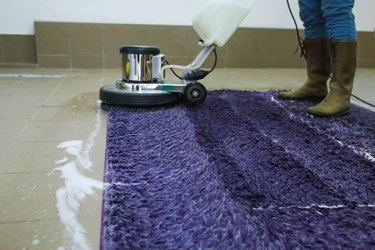
It's highly contagious and often fatal, so parvo is just about the last thing puppy owners want to hear the vet say. Parvo is caused by the parvovirus, which can be easily transmitted through physical contact. If an infected puppy or anyone who has recently been in contact with the virus moves through your home and touches the carpets or walls, the virus could survive there for months, so thoroughly cleaning all surfaces is a good idea. Basic bleach is the most effective disinfectant for many household surfaces, though puppy owners may need to buy a special parvo carpet cleaner to treat a rug without staining it.
Safety Precautions While Cleaning
Video of the Day
Using bleach to disinfect surfaces is generally safe as long as you take some basic precautions. Wear rubber gloves and eye protection whenever you are handling bleach, and keep kids and pets away during the cleaning process.
Video of the Day
Never mix bleach with other cleaners and never use it at full strength. Dilute it using one part bleach to around 30 parts water; that's about 1/2 cup bleach for every gallon of water. When you're done cleaning the infected area, change into clean clothing and wash or throw away any cleaning supplies that may have been infected.
Bleach degrades over time. If your bottle is more than six months old, it may not have maximum disinfecting power, and with something as infectious as the parvovirus, you can't take chances. Open a new bottle.
Cleaning Parvo From Walls
Bleach disinfects but doesn't clean. For best results, pre-clean the walls. Put a few drops of mild dish soap in a spray bottle, add water, spritz the water over the walls and wipe it away with paper towels. Put these towels in a closed trash bag so they can't spread any virus.
Next, rinse out the soapy spray bottle and carefully pour in some of the diluted bleach. Spray the solution all over the part of the wall you want to clean. Let it sit for 10 minutes. Use damp paper towels to rinse the wall and follow with a dry cloth.
A one-part bleach, 30-part water solution shouldn't damage most kinds of walls. Even painted walls and wallpaper should be undamaged by diluted bleach. The bleach solution may also be fine to use on wooden walls that have been treated with some sort of sealant. Unfinished wood may be stained by bleach. No matter what kind of wall treatment you have, apply the bleach solution in an out-of-the-way test spot and wait 10 minutes to see if any change occurs before using the bleach in more noticeable areas of the room.
Parvo Carpet Cleaner
Unfortunately, there aren't a lot of good options for parvo disinfectant for carpet. A bleach solution will stain most kinds of carpets. Steam cleaning the carpet may kill at least some of the parvovirus if any of it is lingering in the fibers. Smaller rugs can be moved outdoors, hosed down and left to dry in the sun, which should at least reduce the amount of virus on the carpet (if not entirely kill it).
There are a few commercial products that are approved as parvo carpet cleaners or parvo disinfectant for carpet. They're fairly expensive, so puppy owners may want to check with their vets before buying any parvo carpet cleaners. The office staff should be experienced with handling the virus and may be able to recommend or even sell you an effective, safe parvo disinfectant for carpet.